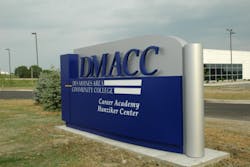At the Frontline: Des Moines Area Community College Director of Campus Safety Ned Miller
With school shootings such as Newtown, Virginia Tech and Columbine forever etched in the memories of Americans, there is perhaps no greater spotlight within the security industry than those responsible for safeguarding the nation’s K-12 and higher education campuses. Protecting against active shooter scenarios, however, is only one of many challenges that school security and safety personnel face on a daily basis.
The threat landscape also changes dramatically depending upon the campus environment being secured. According to Ned Miller, director of campus safety and emergency management at Des Moines Area Community College in Iowa, college campuses like DMACC serve a large community of students, staff and faculty members in what is an inherently dynamic environment.
"We are an open, easily accessible campus. It’s important that we’re friendly, open and people can come and access our services, so we have thousands of people that come and go every day," says Miller. "Then you add to that the expectation that we make our campus safe. We’re no different really from the mall or a big box department store where people come and go every day also and have that same expectation."
Miller will join SIW for a webinar on Wednesday, Oct. 16 at 1 p.m. ET to discuss how he’s using high-definition surveillance technology to improve safety on the DMACC campus. Click here for more information or to register.
In this "At the Frontline" interview, Miller discusses the evolution of campus security and how technology is helping schools become more proactive when it comes to mitigating threats.
SIW: Where did you get your start in security and how did it lead you to your current position at DMACC?
Miller: I’ve been involved in education for many years at a couple of different locations, as well as human resources and safety in an industrial setting. When I came to DMACC as safety officer, I started out more in the role of OSHA safety, employee safety and those types of things. Three years ago, I was given the role of being director of campus safety and then the security side started coming into that. But most of the things I’ve been involved with are people and personnel safety in the educational and factory setting. It’s really a people business and how to get them to be involved in and get them to buy into what you’re trying to do.
SIW: What would you say is your biggest challenge as a security director for a large campus like DMACC?
Miller: I’m not sure you can say what the one biggest challenge is because from day-to-day that changes. But’s it’s trying to balance what we call an open campus environment with the expectations that people have today because of various things that have happened around the country. So, it is striking that balance of openness and having comfort in knowing that we’re doing what we can on a limited budget.
SIW: What would you say have been some of the biggest changes you’ve seen in campus/education security during your career?
Miller: I think that we try to take a more proactive approach with doing more training and awareness type things versus a reactive approach to what happens in trying to deal with things after they’ve happened. From my perspective, in the past, there weren’t some of these major events that have happened. They are not new - campus violence, campus shootings and active shooters – but if you go back 10 or 15 years, some of the events starting with Columbine and then Virginia Tech, Northern Illinois and others, it has just made us be more proactive in making people aware, putting things in place as far as training and response activities and putting in more CCTV cameras as a tool.
SIW: How have advancements in surveillance enabled you to better protect staff and students at your facility?
Miller: For one thing, the technology that’s there today is better, so the image quality is better, but equally if not more important than that is the ease of use of the systems. You can quickly get to the cameras to see what is happening or what has happened and use them as a diagnostic tool. You’ve got better quality and more user-friendly platforms.
SIW: How do you expect recent events such as Sandy Hook to impact education security on all levels moving forward?
Miller: I think what it does is reinforces the fact that, unfortunately, those types of events can and do happen and makes us more aware to try the best we can to put things in place to try and prevent them. The good thing is they still don’t happen every day and they’re fairly infrequent; the bad thing is when they happen they’re horrific. We do the things we can with the resources we have to try and prevent them and I’m not sure that’s a completely accomplishable task.
About the Author
Joel Griffin
Editor-in-Chief, SecurityInfoWatch.com
Joel Griffin is the Editor-in-Chief of SecurityInfoWatch.com, a business-to-business news website published by Endeavor Business Media that covers all aspects of the physical security industry. Joel has covered the security industry since May 2008 when he first joined the site as assistant editor. Prior to SecurityInfoWatch, Joel worked as a staff reporter for two years at the Newton Citizen, a daily newspaper located in the suburban Atlanta city of Covington, Ga.

